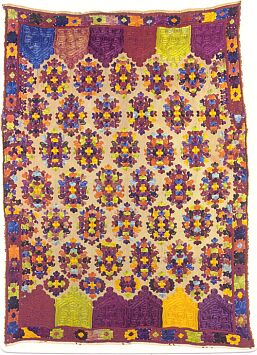Yesterday, I made a second visit to the Moroccan textiles exhibit currently at the Smithsonian's Museum of African Art here in Washington, DC.
I walked through trying to keep in mind some of the things that have been discussed in this salon.
There is a nice full-color catalog of this exhibition priced very reasonably at $45. I did not buy it, but looking through it and at the items displayed again, I was particularly struck by the fact that there are included some embroideries, estimated to be 1800 or earlier that are very detailed, controlled and with designs that seem rather unlike those we associate with most Moroccan weaving. The gallery labels on some of these embroidered pieces indicate that there was a time when such embroidery (it seems to have be urban) drew on designs that one sees in Turkish embroidery. And it is true that such resemblance can be seen.
While I do not have an example image of the embroideries referred to above to show you, there is one other kind of Moroccan urban embroidery, of a later period, that I can share and which seems to me also to exhibit a possible Turkish usage.
The image below is from a piece in this exhibition described as a Moroccan "chest cover," estimated to have been made about 1900 in Rabat.

This piece is fully embroidered in silk on a linen ground. It is bigger than a Turkish yastik at 51 1/4 X 36 1/2 inches, but it has at least one usage that echoes a common yastik feature.
You will have noticed that this is the fact that it has "lappet-like" devices at both ends. Lappets occur in Turkish weavings not only on some yastiks, but on larger rugs as well.
The odd thing about this particular usage is that the lappets have been reversed from the position in which they occur in the Turkish usages I have seen. In Turkish pieces, the tapered ends of the lappets point to the outside edge of the weaving. Here they point inward and become more implicated in (less separate from) the field design than they are in the Turkish usage. We sometimes say that such alterations from the usual suggest that the weaver/embroidery maker is not fully familiar with the design feature being used.
Nevertheless, this usage is one that one could point to as a possible instance of the visible influence of practices in distant Islamic countries on the textiles of Morocco.
Notice also that, although the "lappet-like" forms in this embroidered piece are of a single color, they each carry a rather fully worked internal design of embroidered texture.
Regards,
R. John Howe